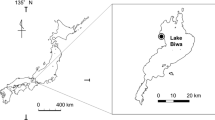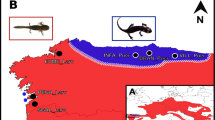Synopsis
This study deals with ecological differences influencing reproductive isolation between two sympatric populations, the small and middle forms, of the striated spined loach. As natural hybrids are rare, isolation between these populations must be complete. There are some differences in their reproduction and early life history. Both reproduce in temporary waters flooded in summer, but their spawning sites are isolated from each other. The small form spawns in shallow areas of still water around irrigation creeks or fens. On the other hand, the middle form spawns in slow-flowing ditches. Spawning site segregation between them is an important isolating mechanism, and is a by-product of adaptation in their early life history.
Similar content being viewed by others
References cited
Halyk, L.C. & E.K. Balon. 1983. Structure and ecological production of the fish taxocene of a small floodplain system. Can. J. Zool. 61: 2446–2464.
Hirshfield, M.F. & D.W. Tinkle. 1975. Natural selection and the evolution of reproductive effort. Proc. Nat. Acad. Sci. USA 72: 2227–2231.
Kaplan, R.H. 1980. The implication of ovum size variability for offspring fitness and clutch size within several populations of salamanders (Ambystoma). Evolution 34: 51–64.
Kawamura, T. 1944. A fundamental investigation on loach breeding in the paddy field. Private printing, Hiroshima. 19 pp. (In Japanese).
Kishi, Y. 1979. A graphical model of disruptive selection on offspring size and a possible case of speciation in freshwater gobies characterized by egg-size difference. Res. Popul. Ecol. 20: 211–215.
Kuramoto, M. 1978. Correlations of quantitative parameters of fecundity in amphibians. Evolution 32: 287–296.
Kurasawa, H. 1955. The seasonal succession of plankton in the paddy field. Bull. Biogeogr. Soc. Japan 16–19: 428–432. (In Japanese).
Kurihara, Y. 1978. Studies of ‘succession’ in a microcosm. Sci. Rep. Tohoku Univ. Ser. IV (Biol.) 37: 151–160.
Littlejohn, M.J. 1981. Reproductive isolation: a critical review. pp. 298–334.In: W.R. Atcheley & D. Woodruff (ed.) Evolution and Speciation: Essays in Honor of M.J.D. White, Cambridge University Press, Cambridge.
Lodi, E. 1967. Sex reversal ofCobitis taenia L. (Osteichthyes, fam. Cobitidae). Experientia 23: 446–447.
Mecham, J.S. 1961. Isolating mechanisms in anuran amphibians. pp. 24–61.In: W.F. Blair (ed.) Vertebrate Speciation, University of Texas Press, Austin.
Minamori, S. 1950. Isolating mechanisms in the striated spinous loach,Cobitis taenia striata. J. Sci. Hiroshima Univ. Ser. B, Div. 1, 11: 55–59.
Minamori, S. 1952. Physiological isolation in Cobitidae I. Two races of the striated spinous loach with special reference to the difference in their embryonic respiration. J. Sci. Hiroshima Univ. Ser. B, Div. 1, 13: 199–212.
Minamori, S. 1957. Physiological isolation in Cobitidae VI. Temperature adaptation and hybrid inviability. J. Sci. Hiroshima Univ. Ser. B, Div. 1, 17: 65–119.
Nikolsky, G.V. 1963. The ecology of fishes. Academic Press, London. 352 pp.
Robotham, P.W.J. 1978. Some factors influencing the microdistribution of a population of spined loach,Cobitis taenia (L.). Hydrobiol. 61: 161–167.
Robotham, P.W.J. 1981. Age, growth and reproduction of spined loach,Cobitis taenia (L.). Hydrobiol. 85: 129–136.
Roff, D.A. 1984. The evolution of life history in teleosts. Can. J. Fish. Aquat. Sci. 41: 989–1000.
Saitoh, K. 1986. A preliminary note on chromosomes of F1 hybrid between middle and small races of the striated spined loach (Cobitis taenia striata). Ann. Rep. Biwako Bunkakan 4: 62–65.
Saitoh, K. & H. Aizawa. 1987. Local differentiation within the striated spined loach (thestriata type ofCobitis taenia complex). Japan. J. Ichthyol. 34: 334–345.
Saitoh, K., O. Katano & A. Koizumi. 1988. Movement and spawning of several freshwater fishes in temporary waters around paddy fields. Japan. J. Ecol. 38: 35–47. (In Japanese).
Williams, D.D. & B.W. Coad. 1979. The ecology of temporary streams III. Temporary stream fishes in Southern Ontario, Canada. Int. Rev. ges. Hydrobiol. 64: 501–515.
Author information
Authors and Affiliations
Rights and permissions
About this article
Cite this article
Saitoh, K. Reproductive and habitat isolation between two populations of the striated spined loach. Environ Biol Fish 28, 237–248 (1990). https://doi.org/10.1007/BF00751037
Received:
Accepted:
Issue Date:
DOI: https://doi.org/10.1007/BF00751037




